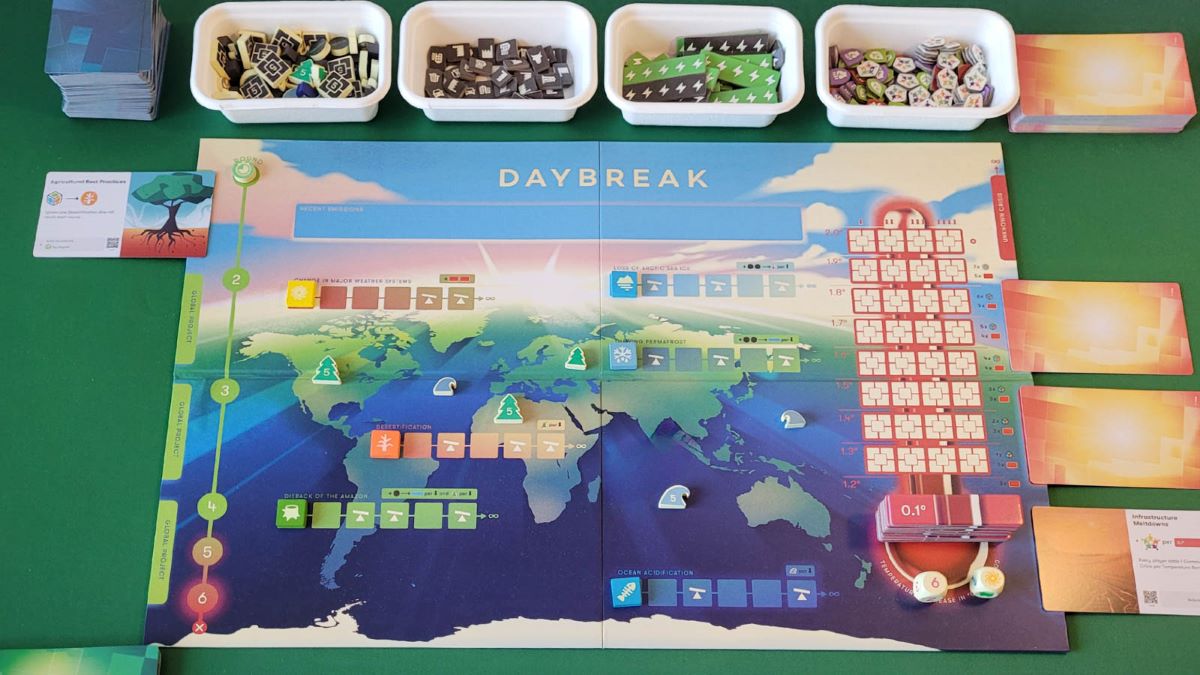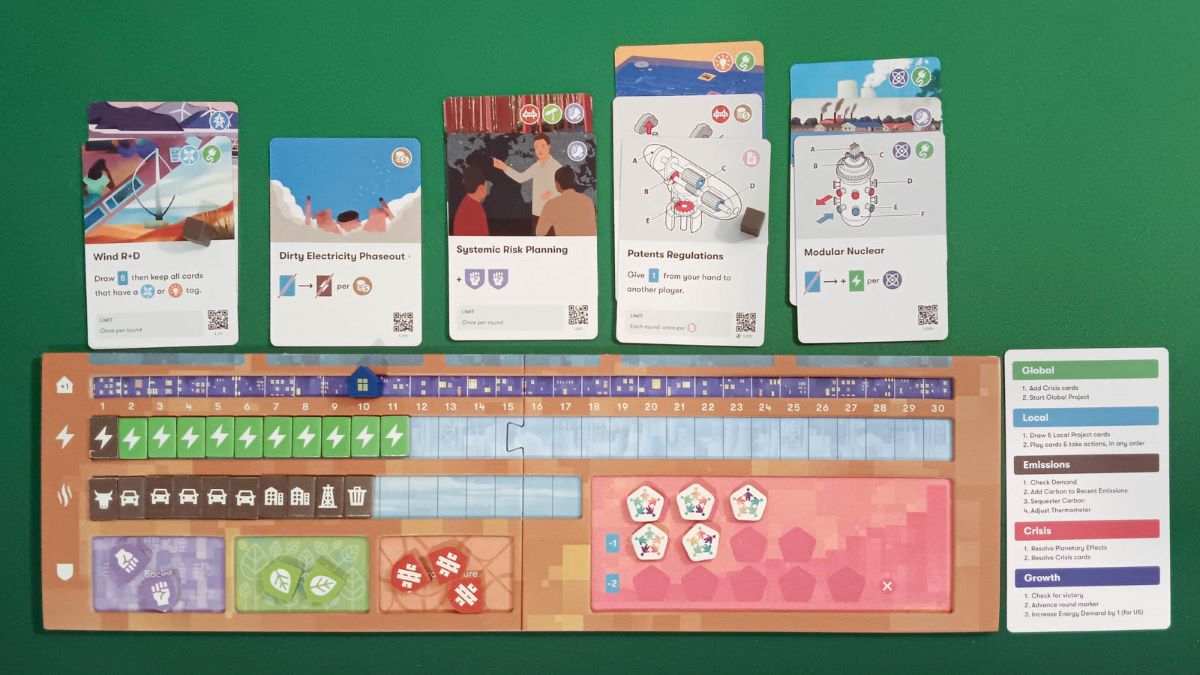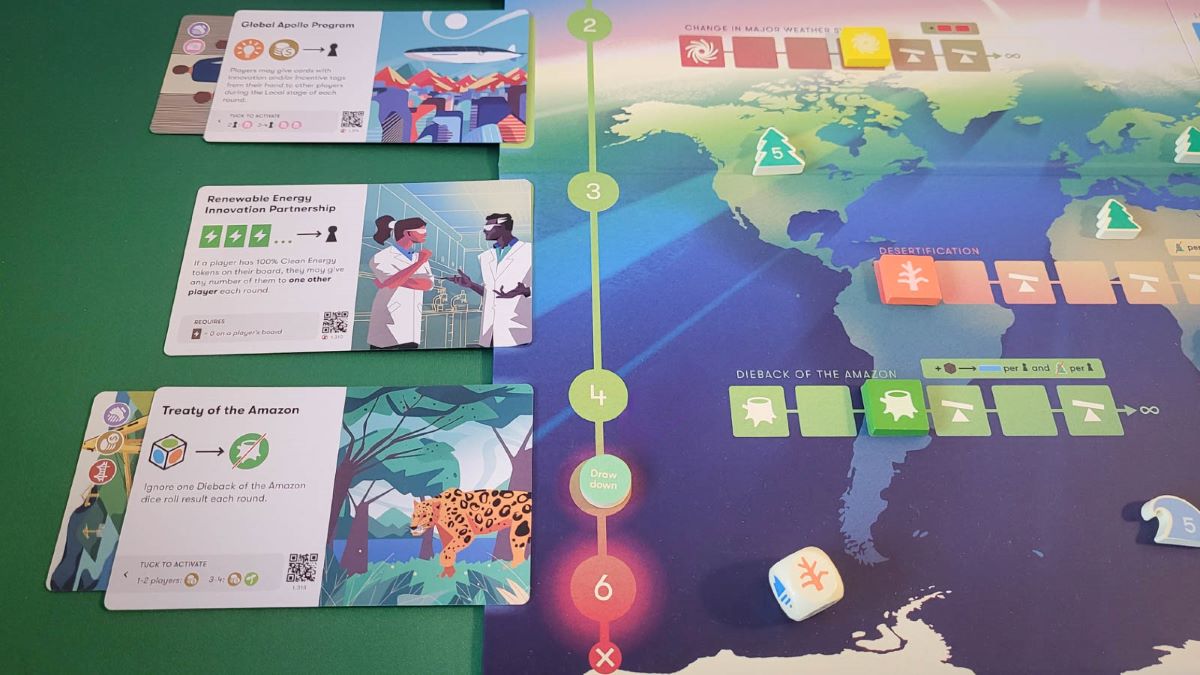Daybreak Review
Year: 2024 | Players: 1-4 | Min: 60+ | Ages: 10+
This Daybreak review was made after playing the game six times. The publisher sent us a copy of this game in exchange for an honest review.
What is Daybreak?
Daybreak is a cooperative environmental game in which you attempt to fight climate change before the global temperature gets too high.
Daybreak was designed by Matt Leacock and Matteo Menapace and is published by CMYK.
Rules Overview
In Daybreak, you and your team take on roles as major world powers, working together to mitigate climate change. Your goal is to reach “Drawdown,” which is when you remove more carbon from the atmosphere than you produce. But if temperatures rise too high or too many communities are put into crisis, you’ll lose the game.
Turn Structure
Daybreak is played in rounds, each with five stages:
1. Global Stage
This is when you review the forecasted Crisis card and choose a Global Project. The forecasted Crisis card reveals a climate threat that players can prepare for, while additional Crisis cards remain facedown until the end of the round. Global Projects provide benefits like clean energy or increased resilience but require you to sacrifice cards or prepare your boards in a specific way to activate them.
2. Local Stage
Everyone focuses on actions on their own boards, using Local Project cards to reduce emissions, switch to clean energy, and boost resilience. Cards can be played in multiple ways: in front of a column to use that card’s effect, behind another card to add more tags to that column, or discarded to use abilities on other cards.
3. Emissions Stage
Carbon emissions are calculated based on each player’s energy mix, with resources like trees and oceans sequestering as much carbon as possible. Any excess carbon goes to the Thermometer, raising global temperatures and potentially triggering crisis effects. If all emissions are sequestered, Drawdown is achieved, potentially leading to a win if you survive the next Crisis Stage.
4. Crisis Stage
The Planetary Effects die is rolled, advancing critical environmental impacts like desertification and sea ice loss. Then, Crisis cards are resolved, with each card potentially impacting resources or communities.
5. Growth Stage
This is when you check if you’ve reached Drawdown. If not, the round tracker advances, and each player’s energy demand increases.
Winning and Losing
You’ll win by achieving Drawdown and making it through one last Crisis stage.
You’ll lose if temperatures reach 2.0°C, if any player has 12 or more communities in crisis, or if you fail to reach Drawdown by the end of the sixth round.
Pros and Cons
Pros
- I’m a huge fan of Daybreak’s hand/resource management system. It allows you to pull off some very satisfying combos, such as activating a card’s ability, then covering it to use its tags to strengthen the effect of the new card. It kind of reminds me of the tableau building in Terraforming Mars, one of my favorite competitive games.
- The designers did an outstanding job of bringing the theme to life. Carbon feels like the enemy as it slips past your trees and hits the atmosphere, and the projects and crises have images and short titles that make their importance clear without heavy text. While the game is streamlined (as it needs to be), you still come away feeling a bit more informed about these issues.
- I like that you can keep cards between rounds, and I wish more card-driven cooperative games had this option. It might seem like a small thing, but sometimes holding a card and waiting for more cards that can potentially support it can be the difference between winning and losing.
- Daybreak seems to have incredible replayability, largely thanks to its huge stack of Local Project cards. The order in which those cards are drawn changes your strategies, making each game feel unique. I’ve played six games so far and each one played out very differently.
- It’s awesome that the cards include QR codes to give you a bit more info about them. Each code leads to a webpage that explains the card’s real-world inspiration and a detailed description of its in-game function. Very cool.
- I was initially worried about potential quarterbacking since all information is open to everyone, but I didn’t experience any of that with the three groups I played with. You can help out your teammates if they’re stuck, but you’re more focused on your own board and then adjust based on what your teammates plan to do.
- I like how easily you can tweak the difficulty by using the included Challenge cards. You can use one or more cards to make it a lighter experience or a more intense challenge, which keeps the game fresh and accessible for all types of players.
- The rulebook is outstanding. The first half gives a high-level overview of the game’s concepts, and the second half gives detailed rules with gameplay examples. I hope more publishers adopt this format for medium-weight and more complex games.
Cons
- So far, wins have lacked a bit of excitement. Games tend to end quietly once you reach Drawdown, and you usually have a good sense beforehand if you’re going to win or not. Unlike most other co-ops that build tension up to the final moments, Daybreak doesn’t have that adrenaline-fueled finish, making victories feel rewarding but not very exciting.
- There’s plenty of cooperation through communication, but I wish there were more cooperative actions. There are some ways to share cards and resources, but having more ways to team up would make the game feel even more collaborative.
- Each world power starts with different cards and resource quantities, but the gameplay feels basically the same. I think adding in a few unique abilities or actions would help each power feel more distinct.
Final Thoughts
Daybreak is one of my favorite cooperative board games of the last few years.
For one, it offers a truly unique co-op experience, which is pretty rare these days. It’s also a nearly perfect blend of theme and mechanics, making it easy to understand your actions and each “stage” of a round while providing a rewarding sense of accomplishment when you pull off cool combos.
Sure, I’d tweak a few things to better suit my group, but we all agree that it’s one of the best board games we’ve played recently.
Like two other co-op environmental games I enjoy playing, Endangered and CO₂: Second Chance, Daybreak is educational while also being a really good game regardless of its theme. The theme comes through every card and action, but even without it, the game’s mechanics are strong and deliver a fantastic experience.
Unless you are brand new to modern board games—check out the Best Gateway Games page if you are—or you only like fast-paced or high-tension games, I highly recommend playing Daybreak. It’s an awesome cooperative game.
- Update: Daybreak was added to our Top 40 Cooperative Board Games!
Daybreak Links
BGG | Amazon | Miniature Market
Thanks for taking the time to read our Daybreak review!
Be sure to also take a look at our Best Cooperative Board Games list and the other board game rankings.
Subscribe to our newsletter if you want more co-op board game content sent right to your inbox!
[Sassy_Social_Share title=”Share this page”]




